THOMASTON, MAINE — Four years after a collision in Long Island Sound nearly sank the Schooner Hindu, a stem-to-stern rebuild of the historic boat has progressed enough to put her back in the water next month, according to owners Josh Rowan and Erin Desmond.
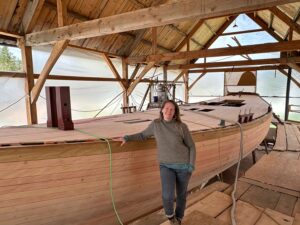
They hope to have the wooden vessel back in Provincetown Harbor for the Blessing of the Fleet on June 30 and recertified by the Coast Guard for public trips by mid-July.
The Hindu, originally built in Maine in 1925, has taken tourists and locals on pleasure sails in Provincetown Harbor nearly every summer since 1946. Generations of Outer Cape residents have served as part-time crew, including this reporter from 2015 to 2019.
The Hindu was already due for a major overhaul when, on her way north from a winter season in Florida, she struck the hull of a sunken fiberglass boat that was half-filled with air and suspended in the shipping lanes off the coast of Connecticut.
If the wreck had struck the Hindu’s side planks, she might have sunk in minutes, Rowan told the Independent. Instead, it struck the strongest part of her prow, and she limped first to Provincetown and then to Maine, where she has been ever since, being disassembled and reassembled with new lumber and brass fittings.
“We had already planned to redo the deck, the side planks, and the centerline, or backbone, of the boat,” Rowan said. The rib-like “frames” that give the boat its shape had been rebuilt by a prior owner in 2005, so there should have been a good skeleton to work with, he said.
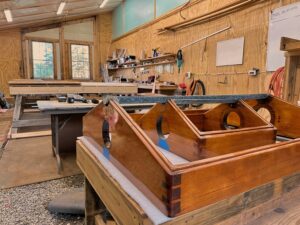
“When we pulled up the planks in August 2020, we found the frames had been rebuilt less than four inches thick when they should have each been six inches — that’s why the deck had flattened out and was leaking so badly,” Rowan said. “We considered just giving up and burning the boat, because that’s when it went from an 18-month project to a four-year $800,000 project.”
Rowan and Desmond did not give up, however — they got engaged. They married in 2022.
The couple spent most of the last four years working on the Hindu, stopping in the summers to bring their newer wooden boat, the Bloodhound, to Provincetown to run sailing trips.
“About two-thirds of that $800,000 is skilled labor — 10 or 12 experienced shipbuilders who worked on various parts of the project,” said Desmond. “The other third is materials — lumber from Suriname, Africa, Burma, Oregon, and Georgia.”
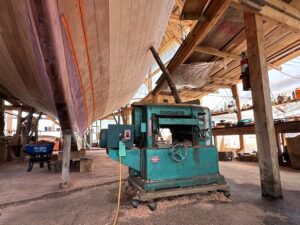
“You also have to consider the cost of time,” Rowan said. “When we’re working on this, we can’t run trips, and wooden boats really need to be earning income to pay their costs.”
Rowan and Desmond were able to raise about $75,000 for the project, and Provincetown voters contributed $73,500 in Community Preservation Act funds at town meeting in 2023.
Nonetheless, the completion date seemed to keep slipping further into the future. The couple took out a $300,000 loan last fall so they could pay shipwrights to get the boat ready to work this July.
“Tom Johnson at Seamen’s Bank was incredible,” Rowan said. “We put up pretty much everything we own as collateral, but that loan let us hire eight shipwrights to work all winter long and get two years’ worth of work done in eight months.”
Back to Provincetown
The Hindu and the Bloodhound will both sail from Provincetown this summer, and the Hindu will then work winters in Key West and summers in Provincetown for at least two years to pay back the loan, Desmond said.
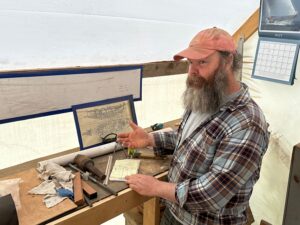
That plan requires two boats and two captains. Desmond took her 100-ton Coast Guard exams this winter and will pilot the Hindu this summer while Rowan steers the Bloodhound.
Eventually both boats will drydock in Maine for a winter so reconstruction of the Hindu’s interior can begin in earnest.
“Her original layout included elegant cabins, and she was refitted with Boy Scout bunks during her ‘Hooligan Navy’ era,” said Desmond, referring to the Hindu’s years in the World War II Corsair Fleet, when wooden yachts were enlisted in Coast Guard patrols because they could not be detected by German sonar.
“It was that Coast Guard era that helped ensure her future,” Rowan said, “because they added the lifelines around the deck, fire suppression systems, and copper lining in the engine room. Most wooden yachts lasted 30 years, but those upgrades meant she was Coast Guard approved for passengers after the war, and that’s how she earned her keep.”

Desmond and Rowan plan to restore the original cabin layout, which includes two double bunks and six singles.
“We’ve taken a lot of elements back to William Hand Jr.’s original designs, which we were able to find in MIT’s nautical collections,” Rowan said. The transom at the back of the boat, for instance, is now at a steeper angle in accordance with those drawings.
“We also made the vessel a lot more inspectable — she’s designed so that the Coast Guard can get to the chain plates in 20 minutes instead of two weeks of disassembling woodwork to reach them,” Rowan said. “I call her Dorian Gray because she looks brand new, and I’m the one aging.”
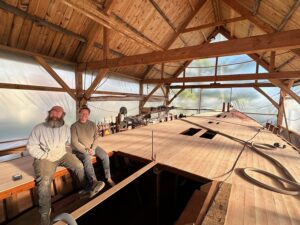
The Hindu is due to be painted in late May, which will conceal the half-dozen species of wood used to rebuild her. Rowan said the final steps of the project are in some ways the hardest.
“I’ve been trying to convince people to come see her, because once you close her up you can’t appreciate the real beauty of the woodwork,” Rowan said. “Before we put the planking on the sides, her skeleton was like the most beautiful sculpture.
“Every beam that runs under the deck is dovetailed into its clamp — it’s the most beautiful joint you’ve ever seen, so complicated and so perfect, and now they’re all hidden,” he added.
“This boat could live forever,” Rowan said. “She’s definitely going to outlive me.”



